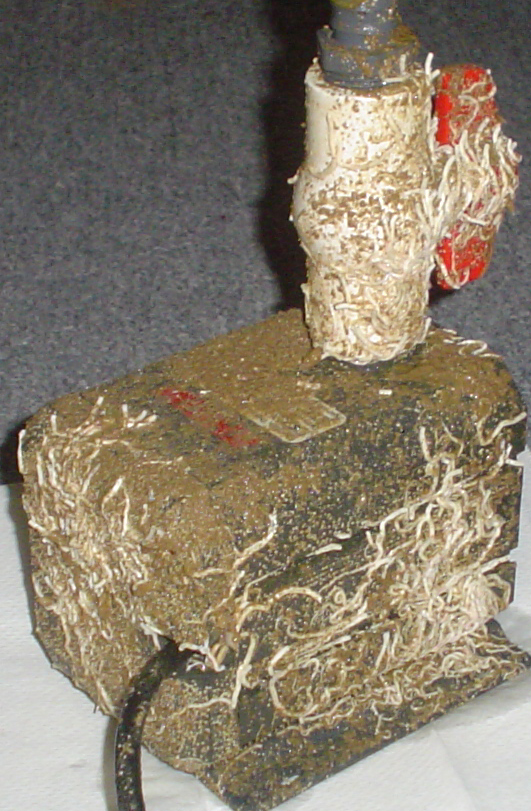Update: Signs of scrubbers wearing out
Since my acrylic scrubber is approching one year old, it's the first one to experience signs of wearing out. Of course I'm also experimenting with large amounts of continuous feeding (which makes things worse), but I'm still seeing some of the same signs in other peoples' scrubbers, even though they are feeding normal amounts, and even though they've replaced the bulbs every 3 months. This is typically what starts happening:
Glass-cleaning is needed more often
Scrubber starts growing darker algae
pH stays at a lower point
Rocks get a light green covering
Cyano starts showing up
Nitrate and phosphate start staying at higher levels
What is probably happening (and what happened to mine) was that the flow had been greatly reduced to the scrubber. My screen is 22" wide, and only half of it was getting any flow at all (I'm surprised half of it did not die); the other half was still getting some flow, but it was so little that the bottom of the scrubber was almost dry. My problem was the pump:

This is a case of scrubbers causing their own unique problem. When you run a scrubber (without skimmers or mechanical filters), not only do the corals and small fish get much more of the food that you feed, but you will also grow all sorts of filter feeders like the ones you see all over the pump in the picture. They grew all through the display, of course (to be eaten by a wrasse), but they also grew up into the impeller area of the scrubber pump, which was the problem. Also in the pic, you can see the brown stuff which was the result of my experiment in large amounts of continuous feeding in a system with a poorly designed sump (which allowed too much settling). The case/impellor was so locked up that I had to soak it in pure vinegar for several hours to even get it open. So while waiting on that, I opened the Eheim 1262 (900 gph) that I ordered as a backup So now my scrubber pump is pumping 2X as much as my return.
So now my scrubber pump is pumping 2X as much as my return.
Once the new pump was in place, there was a forceful waterfall across the screen again. There is so much water in the acrylic box now that it is 1" deep before it goes out the drain hole (whereas before it was almost dry).
Point is, check your scrubber pump often for internal fan worms or food buildup. Just like the lights, you may not be able to see the lower output (since it happens very slowly over time), so you have to open it up and check. Running the pump in vinegar every three months should keep it clear (vinegar disolves fan worms).
Since my acrylic scrubber is approching one year old, it's the first one to experience signs of wearing out. Of course I'm also experimenting with large amounts of continuous feeding (which makes things worse), but I'm still seeing some of the same signs in other peoples' scrubbers, even though they are feeding normal amounts, and even though they've replaced the bulbs every 3 months. This is typically what starts happening:
Glass-cleaning is needed more often
Scrubber starts growing darker algae
pH stays at a lower point
Rocks get a light green covering
Cyano starts showing up
Nitrate and phosphate start staying at higher levels
What is probably happening (and what happened to mine) was that the flow had been greatly reduced to the scrubber. My screen is 22" wide, and only half of it was getting any flow at all (I'm surprised half of it did not die); the other half was still getting some flow, but it was so little that the bottom of the scrubber was almost dry. My problem was the pump:

This is a case of scrubbers causing their own unique problem. When you run a scrubber (without skimmers or mechanical filters), not only do the corals and small fish get much more of the food that you feed, but you will also grow all sorts of filter feeders like the ones you see all over the pump in the picture. They grew all through the display, of course (to be eaten by a wrasse), but they also grew up into the impeller area of the scrubber pump, which was the problem. Also in the pic, you can see the brown stuff which was the result of my experiment in large amounts of continuous feeding in a system with a poorly designed sump (which allowed too much settling). The case/impellor was so locked up that I had to soak it in pure vinegar for several hours to even get it open. So while waiting on that, I opened the Eheim 1262 (900 gph) that I ordered as a backup
Once the new pump was in place, there was a forceful waterfall across the screen again. There is so much water in the acrylic box now that it is 1" deep before it goes out the drain hole (whereas before it was almost dry).
Point is, check your scrubber pump often for internal fan worms or food buildup. Just like the lights, you may not be able to see the lower output (since it happens very slowly over time), so you have to open it up and check. Running the pump in vinegar every three months should keep it clear (vinegar disolves fan worms).









